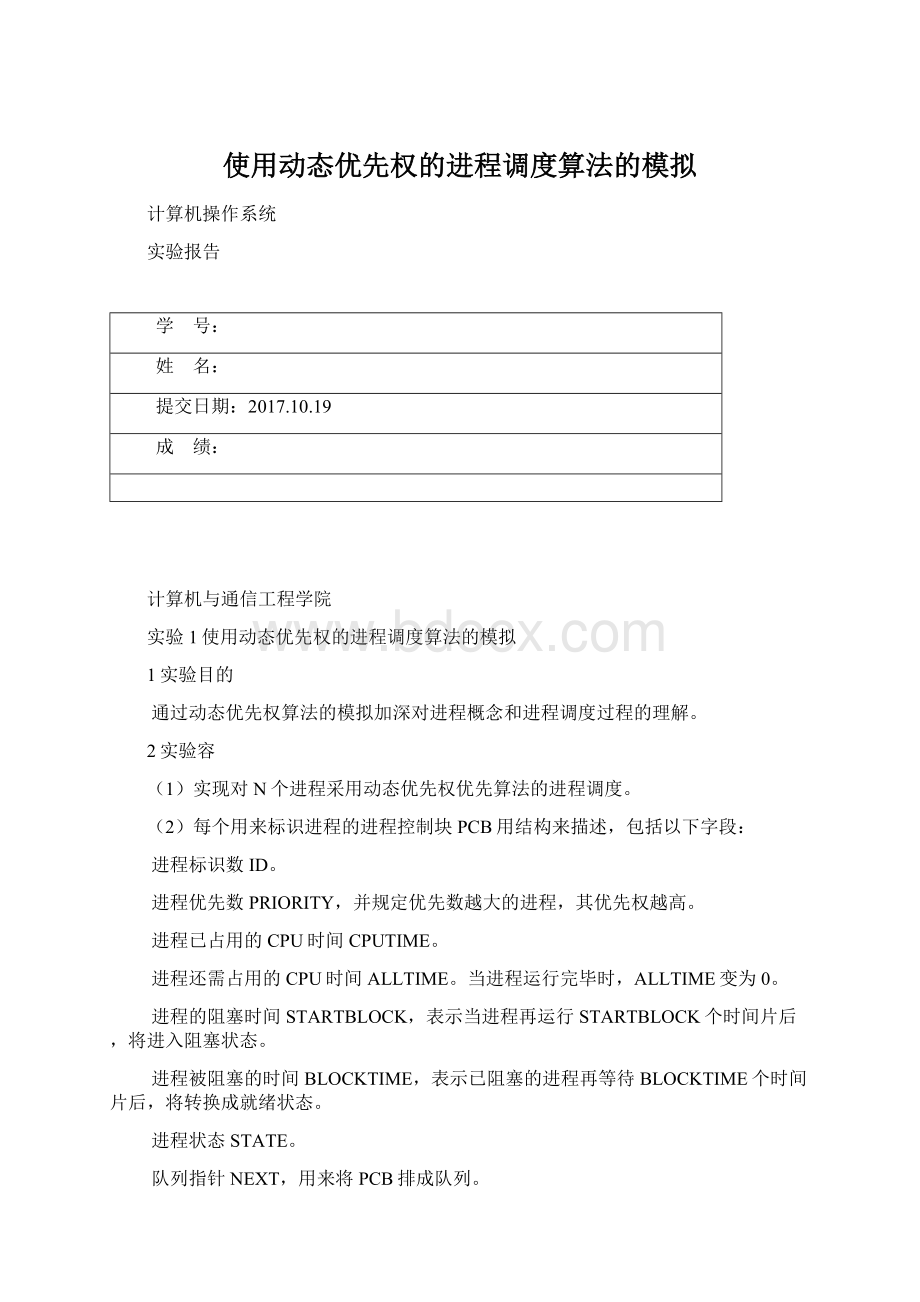 使用动态优先权的进程调度算法的模拟.docx
使用动态优先权的进程调度算法的模拟.docx
- 文档编号:6365934
- 上传时间:2023-01-05
- 格式:DOCX
- 页数:12
- 大小:99.92KB
使用动态优先权的进程调度算法的模拟.docx
《使用动态优先权的进程调度算法的模拟.docx》由会员分享,可在线阅读,更多相关《使用动态优先权的进程调度算法的模拟.docx(12页珍藏版)》请在冰豆网上搜索。

使用动态优先权的进程调度算法的模拟
计算机操作系统
实验报告
学号:
姓名:
提交日期:
2017.10.19
成绩:
计算机与通信工程学院
实验1使用动态优先权的进程调度算法的模拟
1实验目的
通过动态优先权算法的模拟加深对进程概念和进程调度过程的理解。
2实验容
(1)实现对N个进程采用动态优先权优先算法的进程调度。
(2)每个用来标识进程的进程控制块PCB用结构来描述,包括以下字段:
进程标识数ID。
进程优先数PRIORITY,并规定优先数越大的进程,其优先权越高。
进程已占用的CPU时间CPUTIME。
进程还需占用的CPU时间ALLTIME。
当进程运行完毕时,ALLTIME变为0。
进程的阻塞时间STARTBLOCK,表示当进程再运行STARTBLOCK个时间片后,将进入阻塞状态。
进程被阻塞的时间BLOCKTIME,表示已阻塞的进程再等待BLOCKTIME个时间片后,将转换成就绪状态。
进程状态STATE。
队列指针NEXT,用来将PCB排成队列。
(3)优先数改变的原则:
进程在就绪队列中停留一个时间片,优先数加1。
进程每运行一个时间片,优先数减3。
(4)假设在调度前,系统中有5个进程,它们的初始状态如下:
ID01234
PRIORITY93830290
CPUTIME00000
ALLTIME33634
STARTBLOCK2-1-1-1-1
BLOCKTIME30000
STATEreadyreadyreadyreadyready
(5)为了清楚的观察各进程的调度过程,程序应将每个时间片的情况显示出来,参照的具体格式如下:
RUNNINGPROG:
i
READY-QUEUE:
->id1->id2
BLOCK-QUEUE:
->id3->id4
=======================================
ID01234
PRIORITYP0P1P2P3P4
CUPTIMEC0C1C2C3C4
ALLTIMEA0A1A2A3A4
STARTBLOCKT0T1T2T3T4
BLOCKTIMEB0B1B2B3B4
STATES0S1S2S3S4
3实验结果
(1)流程图
(2)程序源代码
#include
#include
#include
typedefstructnode
{
intid;//进程标识数
intpriority;//进程优先数,优先数越大优先级越高
intcputime;//进程已占用的CPU时间
intalltime;//进程还需占用的CPU时间
intstartblock;//进程的阻塞时间
intblocktime;//进程被阻塞的时间
charstate[10];//进程状态
structnode*next;//队列指针
}PCB;
PCB*CreatQueue(intnum)//创建一个就绪队列
{
inti;//i为循环计数器
PCB*head,*temp1,*temp2,*temp3;//head为就绪队列的头指针,temp1为创建进程结点的指针,
temp2、temp3分别为比较结点的前驱结点和比较结点
for(i=0;i { temp1=(PCB*)malloc(sizeof(PCB)); printf("输入第%d个进程的(id…state)\n",i); scanf("%d%d%d%d%d%d%s",&temp1->id,&temp1->priority,&temp1->cputime,&temp1->alltime,&temp1->startb lock,&temp1->blocktime,temp1->state); if(i==0)//如果创建的是第一个结点 { head=temp1; head->next=NULL; continue; } if(head->priority 接把该结点插入到头结点之前 { temp1->next=head; head=temp1; continue; } temp2=head;//temp2为比较结点的直接前驱结点 temp3=temp2->next;//temp3为比较的结点 while(temp3! =NULL&&temp3->priority>=temp1->priority)//实现查找的功能 { temp2=temp3; temp3=temp2->next; } temp2->next=temp1; temp1->next=temp3; } returnhead; } PCB*InsertQueue(PCB*head,PCB*run)//在就绪队列中插入一个结点 { PCB*temp1,*temp2;//temp1和temp2分别为比较结点的前驱和比较结点 if(head==NULL)//如果就绪队列为空 { head=run; head->next=NULL; } elseif(head->priority 结点插入到头结点之前 { run->next=head; head=run; } else { temp1=head;//temp1为比较结点的直接前驱结点 temp2=temp1->next;//temp2为比较的结点 while(temp2! =NULL&&temp2->priority>=run->priority)//实现查找的功能 { temp1=temp2; temp2=temp1->next; } temp1->next=run; run->next=temp2; } returnhead; } main() { intnum;//num为进程的个数 intalltime=0;//用来保存所有进程需要占用的CPU时间 PCB*head;//head为就绪队列的头指针 PCB*run=NULL;//run为执行进程结点的指针 PCB*block=NULL;//block为阻塞进程的结点 PCB*temp; printf("请输入进程的个数: "); scanf("%d",&num); head=CreatQueue(num); getchar(); temp=head; while(temp! =NULL) { alltime+=temp->alltime; temp=temp->next; } while(alltime>0) { if(head! =NULL) { run=head;//把就绪队列中的第一个进程取出来执行 head=head->next;//就绪队列的头指针指向下一个结点 strcpy(run->state,"run");//状态改为执行 run->next=NULL; /*显示状态*/ printf("RUNNINGPROG: %d\n",run->id);//显示执行进程 printf("READY_QUEUE: ");//显示就绪进程 temp=head; while(temp! =NULL) { printf("->%d",temp->id); temp=temp->next; } printf("\n"); printf("BLOCK_QUEUE: ");//显示阻塞进程 if(block! =NULL) { printf("%d",block->id); } printf("\n"); printf("============================================================================\n"); printf("IDPRIORITYCPUTIMEALLTIMESTARTBLOCKBLOCKTIMESTATE\n"); printf("%d%d%d%d%d%d %s\n",run->id,run->priority,run->cputime,run->alltime,run->startblock,run->blocktime,run->state); temp=head; while(temp! =NULL) { printf("%d%d%d%d%d%d%s\n",temp->id,temp->priority,temp->cputime,temp->alltime,temp->startblock,temp->blocktime,temp->state); temp=temp->next; } if(block! =NULL) { printf("%d%d%d%d%d%d%s",block->id,block->priority,block->cputime,block->alltime,block->startblock,block->blocktime,block->state); } printf("\n"); printf("============================================================================\n"); /*显示状态*/ /*改变优先数*/ run->priority-=3;//执行进程的优先数减3 temp=head; while(temp! =NULL)//就绪进程的优先数加1 { temp->priority+=1; temp=temp->next; } /*改变优先数*/ /*改变执行进程的有关参数*/ run->cputime+=1;//执行进程的已占用CPU时间加1 run->alltime-=1;//还需要的CPU时间减1 if(run->alltime! =0) { if(run->startblock>0)//如果该进程会被阻塞 { run->startblock-=1;//执行完一个时间片后,开始阻塞的时间减1 if(run->startblock==0)//如果阻塞的时间到了 { block=run;//执行转阻塞 strcpy(block->state,"b");//状态转阻塞 alltime--; printf("\n"); continue; } } strcpy(run->state,"r");//状态转就绪 head=InsertQueue(head,run);//执行转就绪 run=NULL; } /*改变执行进程的有关参数*/ alltime--; } else { /*显示状态*/ printf("RUNNINGPROG: \n");//显示执行进程 printf("READY_QUEUE: \n");//显示就绪进程 printf("BLOCK_QUEUE: ");//显示阻塞进程 if(block! =NULL) { printf("%d",block->id); } printf("\n"); printf("============================================================================\n"); printf("IDPRIORITYCPUTIMEALLTIMESTARTBLOCKBLOCKTIMESTATE\n"); if(block! =NULL) { printf("%d%d%d%d%d%d%s",block->id,block->priority,block->cputime,block->alltime,block->startblock,block->blocktime,block->state); } printf("\n"); printf("============================================================================\n"); /*显示状态*/ } /*改变阻塞进程的有关参数*/ if(block! =NULL)//如果有阻塞进程 { block->blocktime-=1;//被阻塞的时间减1 if(block->blocktime==0)//如果被阻塞的时间到了 { strcpy(block->state,"r");//状态转就绪 head=InsertQueue(head,block);//阻塞转就绪 block=NULL; } } /*改变阻塞进程的有关参数*/ getchar(); } } 4思考 (1)实际进程调度中,除了按调度算法选择下一个执行的进程外,还需要处理哪些工作? 记录系统中所有进程的执行情况 ,作为进程调度的准备,进程管理模块必须将系统中各个进程的执行特征记录在各个进程的PCB表中。 进行进程上下文切换 ,一个进程的上下文包括进程的状态,有关变量和数据结构的值。 机器寄存器的值和PCB以及有关程序,数据等。 (2)为什么对进程的优先数可按上述原则进行修改? 最高优先权调度算法仅有利于优先权高的进程,当不断有优先权高的进程需调度时,优先权低的进程将很难得到处理机的处理,所以进程在就绪队列中每呆一个时间片,优先数就增加1,使优先权低的进程不总是忙等,优先权随着时间的递增逐步增大。
- 配套讲稿:
如PPT文件的首页显示word图标,表示该PPT已包含配套word讲稿。双击word图标可打开word文档。
- 特殊限制:
部分文档作品中含有的国旗、国徽等图片,仅作为作品整体效果示例展示,禁止商用。设计者仅对作品中独创性部分享有著作权。
- 关 键 词:
- 使用 动态 优先权 进程 调度 算法 模拟
 冰豆网所有资源均是用户自行上传分享,仅供网友学习交流,未经上传用户书面授权,请勿作他用。
冰豆网所有资源均是用户自行上传分享,仅供网友学习交流,未经上传用户书面授权,请勿作他用。


 铝散热器项目年度预算报告.docx
铝散热器项目年度预算报告.docx
